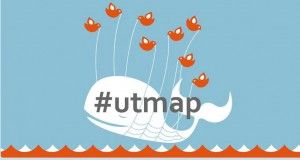By Bert Granberg on Jun 07, 2012
#utmap: A Twitter Tag for Utah GIS
This article will take 1 minute to read
 Twitter is a low commitment social media tool that can be great for professional collaboration and sharing. It allows users to quickly search and scan recent tweets (posts) for relevant information. And, the 140 character limit of Twitter's 'microblog' format is just a starting point. Tweets can include URL links (usually shortened using a URL shortener) that access additional information including pictures, blog posts, code samples, Google and other online documents, map locations, interactive maps, job postings, etc.
Twitter is a low commitment social media tool that can be great for professional collaboration and sharing. It allows users to quickly search and scan recent tweets (posts) for relevant information. And, the 140 character limit of Twitter's 'microblog' format is just a starting point. Tweets can include URL links (usually shortened using a URL shortener) that access additional information including pictures, blog posts, code samples, Google and other online documents, map locations, interactive maps, job postings, etc.
The twitter web site and mobile apps, as well as popular third party twitter clients (hootsuite, tweetdeck, etc) make it easy to view posts by specific individuals, groups, or keywords.
Within tweets, hash tags (anything proceeded directly by the '#' character) allow users to turn portions of their 140 character tweets into keywords or to otherwise add emphasis (#justsayin).
AGRC would like to encourage Utah GIS and map users to both consume and contribute tweets pertaining to anything GIS, mapping, or otherwise geospatial using the hash tag #utmap, following other Utah-specific hashtags such as #utpol (politics) and #uted (education).
If you are a twitter user, or become one, and would like to connect with other #utmap users, you might consider posting an introductory tweet with the #utmap hash tag so others know you're out there and can have the option of 'following' you. Ex. @MapUtah: "I'm now following #utmap tweets."
Like any social media channel, professional users are encouraged to keep content relevant, succinct, and appropriate, knowing that other users expect to be positively impacted by this communication channel.
Happy tweeting.